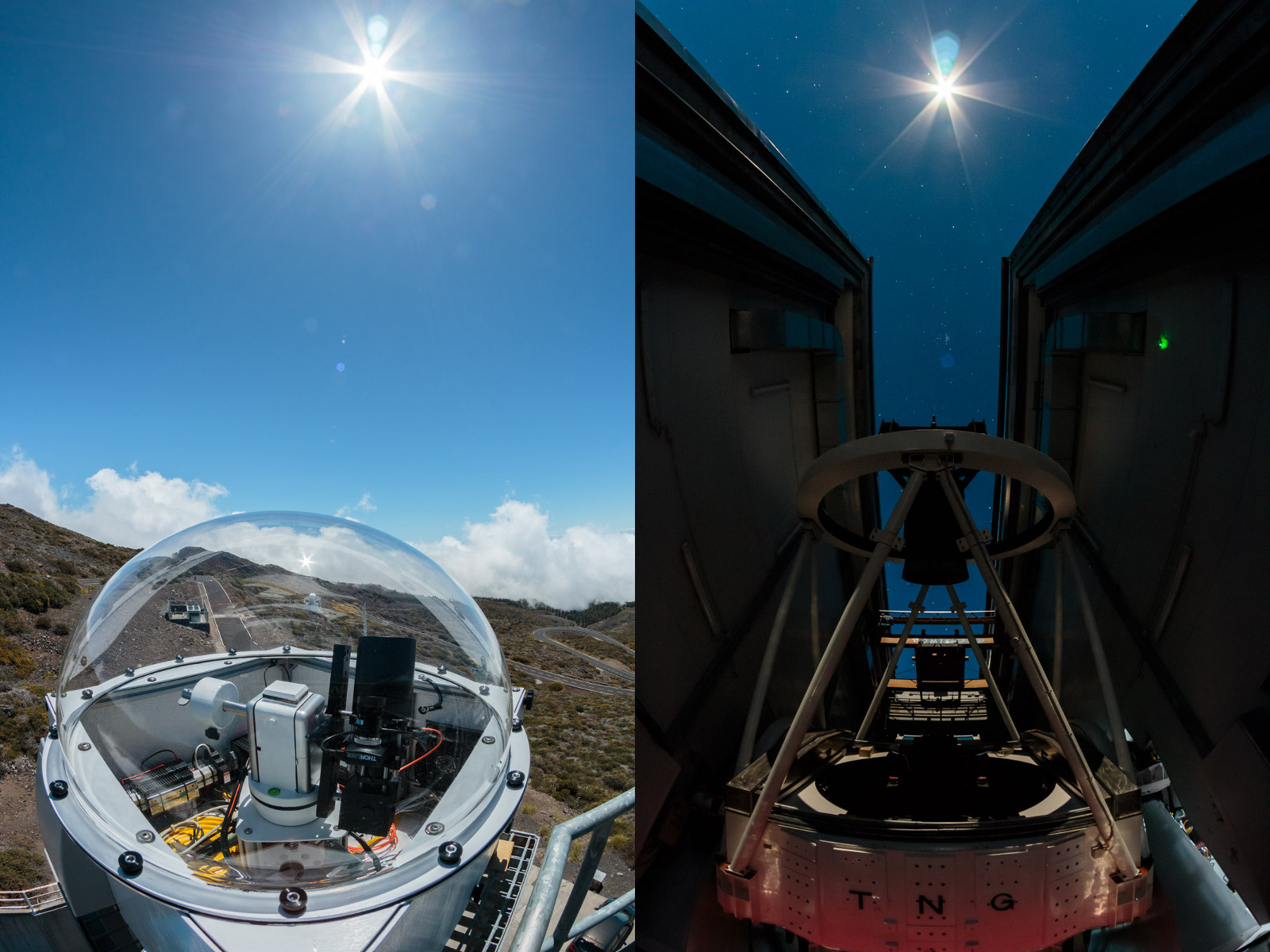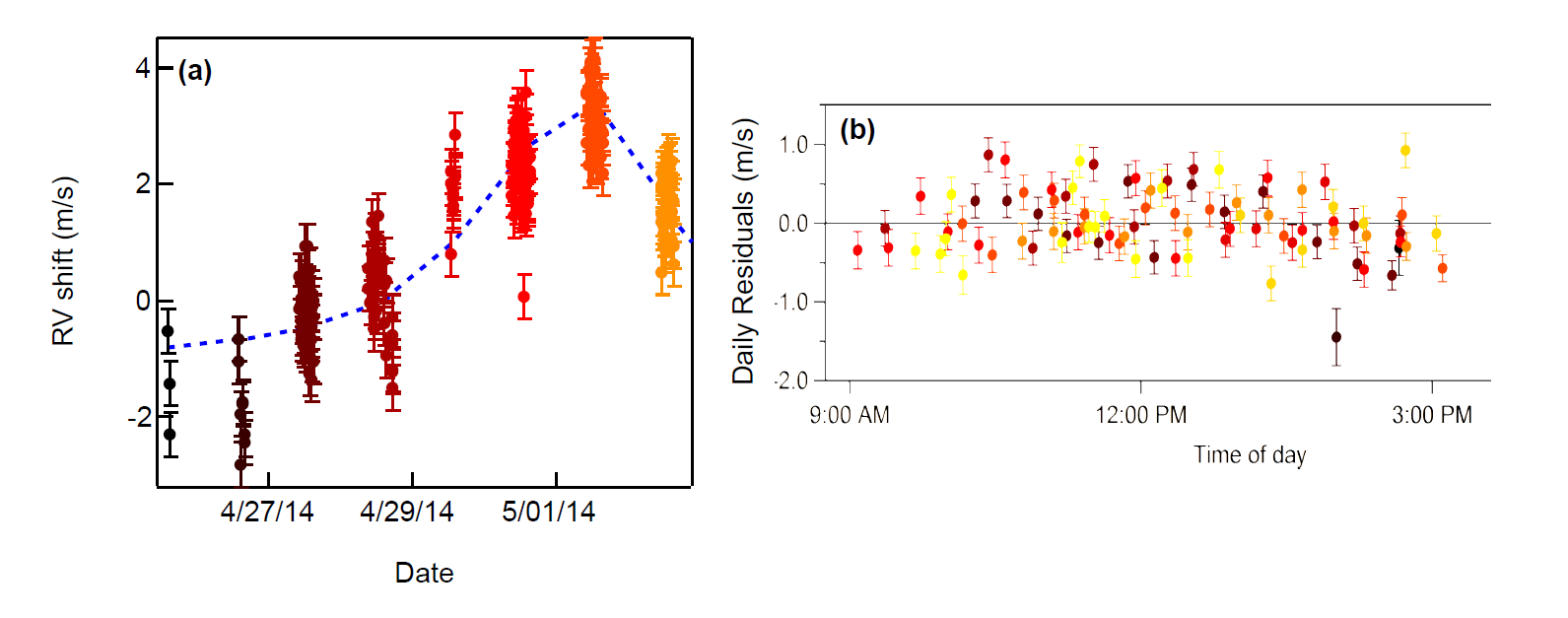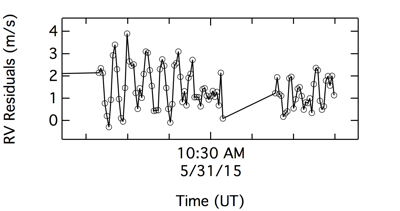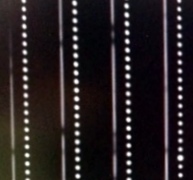TNG, HARPS-N and Astro Comb ready to characterize the first earth twin
From the results of the Kepler satellite, we know that finding an Earth size
planet in the habitable zone of its host star is possible. However, estimating
its mass, which will likely be possible only with the radial velocity (RV)
technique, is much more difficult.
Stellar signal is perturbed by several factors as convection, granulation,
pulsations or active regions; the RV variation induced by such effects is one
order of magnitude larger than the effect of the mass of the planet over its
star.
Understanding how stellar activity influences RV measurements is therefore a
key parameter to the characterization of an Earth twin. A very high cadence
continuous follow up of a star with a high precision spectrograph (Harps-N)
and a stable reference (Astro Comb) is mandatory. However, the night is
already overbooked with observations and during the day one can only
look at the Sun.
Research Scientist David Phillips with PhD Xavier Dumusque and their team from the Harvard-Smithsonian Center for Astrophysics (CfA), in collaboration with the Observatory of Geneva (ObsGe) and the Fundacion Galileo Galilei (FGG) has implemented a totally new experiment at the TNG.
Simulations including realistic stellar signal show that observing the Sun two hours per day for two years would be enough to recover significantly the signal induced by Venus on the Sun. Such a detection would be the ultimate proof that detecting an Earth twin in the near future is not just a dream. However this is not an easy task: not only the RV variations induced from Venus are on the range of less than 10cm/s but the Sun is also affected by intrinsic activity which increase the noise on the collected data.
With these goals, and once figured out the technical issues, a Low Cost
Solar Telescope (LCST) has been installed on the outside of the TNG dome
in May 2015. The LCST, consisting of an achromatic lens and an integrating
sphere sitting on an amateur telescope tracking mount, is housed under a
fixed acrylic dome. Light
For two years from now the LCST will be feeding Sun light to HarpsS-N and the RV variations will be measured with respect to an highly stable reference source which is represented by the Astro Comb. These spectra, with the help of solar satellites (SOHO, SDO, SOURCE ), would allow characterizing all the sources of stellar signal and it would be possible to understand every observed RV variation.
An automatic script activates the solar telescope and Harps-N in the morning and proceeds with observations until the afternoon, when the spectrograph is prepared for night observations with the TNG. Thus the duty cycle of Harps-N will be close to 24 hours. Extensive test are done in these days in characterizing the solar telescope.
In two years of data collection we will be able to demonstrate that the TNG,
together with Harps-N and the Astro Comb have the unprecedented precision and
stability needed (RV < 0.1 m/s) to detect Earth like rocky planets in the
habitable zones of distant Suns. With the correlation between measured RV
variations and data from spacecrafts observing the Sun we will also be able
to associate the measured RV variations with features on the Sun, constraining
the simulations and use these simulations for the observation of other stars.
We will begin by detecting Venus. If we can show that we can see the effect
of Venus (RV ~ 8.6cm/s in 225 days) in the solar spectra we will be able to
detect the effect of exoplanets orbiting around their own stars and fulfill
the need expressed in the 2010 A&A Decadal Survey of characterizing an Earth
twin planet around a GK type star.
Contact: Adriano Ghedina

Left: The LCST, installed outside the dome of the TNG facing South, begins its activity in the morning to feed Sun light to the Calibration Unit of HARPS-N. Right: Night time observation at the TNG, with HARPS-N and the Astro Comb. With the LCST the duty cycle of Harps-N will be of nearly 24h.(credits Alex Glenday)

Initial results from the LCST. Left: Solar RVs after subtracting expected velocities with a fit (blue dashed line) using solar photometry. Right: daily residuals show a standard deviation <40cm/s.

Another initial result from the LCST shows the 5 minutes P-mode oscillation of the Sun in the measured RVs.

A picture of the comb-calibrated solar spectrum; the dots are the Astro Comb emission lines, the continuous columns are the solar spectrum with absorption lines.

